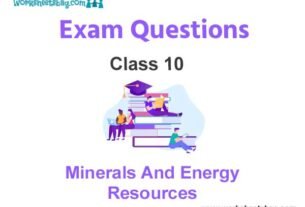Please see The Rise Of Nationalism In Europe Exam Questions Class 10 Social Science below. These important questions with solutions have been prepared based on the latest examination guidelines and syllabus issued by CBSE, NCERT, and KVS. We have provided Class 10 Social Science Questions and answers for all chapters in your NCERT Book for Class 10 Social Science. These solved problems for The Rise Of Nationalism In Europe in Class 10 Social Science will help you to score more marks in upcoming examinations.
Exam Questions The Rise Of Nationalism In Europe Class 10 Social Science
Question. Give a brief note on the Napoleonic code.
Answer : The Civil Code of 1804 – usually known as the Napoleonic Code – did away with all privileges based on birth, established equality before the law and secured the right to property. This Code was exported to the regions under French control.
Question. How was nation visualized by artists?
Answer : Artists in the eighteenth and nineteenth centuries found a way out by personifying a nation. In other words they represented a country as if it were a person.
Question. How did nationalism and the idea of the nation-state emerge?
Answer : Socially and politically, a landed aristocracy was the dominant class on the continent. The members of this class were united by a common way of life that cut across regional divisions.
Question. How did nationalism and the idea of the nation-state emerge?
Answer : Socially and politically, a landed aristocracy was the dominant class on the continent. The members of this class were united by a common way of life that cut across regional divisions. They owned estates in the countryside and also town-houses.
Question. What was the Romantic Imagination about a nation?
Answer : Romanticism, a cultural movement which sought to develop a particular form of nationalist sentiment. Romantic artists and poets generally criticised the glorification of reason and science and focused instead on emotions, intuition and mystical feelings.
Question. On what basis the female allegories were given names?
Answer : Many female allegories were invented by artists in the nineteenth century to represent the nation. In France she was christened Marianne, a popular Christian name, which underlined the idea of a people’s nation.
Question.What did Liberal Nationalism Stand for?
Answer : Ideas of national unity in early-nineteenth-century Europe were closely allied to the ideology of liberalism. The term ‘liberalism’ derives from the Latin root liber, meaning free. For the new middle classes liberalism stood for freedom for the individual and equality of all before the law.
Question. What were the highlights of the Treaty of Vienna 1815?
Answer : In 1815, representatives of the European powers – Britain, Russia, Prussia and Austria – who had collectively defeated Napoleon, met at Vienna to draw up a settlement for Europe. The main highlights were to how the nation could develop and what economic measures could help forge this nation together.
Question. Describe the rise of imperialism.
Answer : Nationalism, aligned with imperialism, led Europe to disaster in 1914. But meanwhile, many countries in the world which had been colonised by the European powers.
Question. Give two examples to show that in the 18th century Europe there were no nation states.
Answer : In the mid-eighteenth-century Europe there were no ‘nation-states’ as we know them today. The countries such as Germany, Italy and Switzerland, which we know today were divided into kingdoms.
Question. Describe the French Revolution.
Answer : The first clear expression of nationalism came with the French Revolution in 1789. France, as you would remember, was a full-fledged territorial state in 1789 under the rule of an absolute monarch. The political and constitutional.
Question. Why were the Middle class so named?
Answer : Socially and politically, a landed aristocracy was the dominant class on the continent. The members of this class were united by a common way of life that cut across regional divisions. They owned estates in the countryside and also townhouses. They spoke French for purposes of diplomacy and in high society.
Question. According to Ernst Renan what are the attributes of a nation?
Answer : In a lecture delivered at the University of Sorbonne in 1882, the French philosopher Ernst Renan (1823-92) outlined his understanding of what makes a nation. The lecture was subsequently published as a famous essay entitled ‘Qu’est-ce qu’une nation?’ (‘What is a Nation?’).
Question. What were the reforms made by Napoleon?
Answer : Within the wide swathe of territory that came under his control, Napoleon set about introducing many of the reforms that he had already introduced in France. Through a return to monarchy Napoleon had, no doubt, destroyed democracy in France, but in the administrative field he had incorporated revolutionary principles in order to make the whole system more rational and efficient. The Civil Code of 1804 – usually known as the Napoleonic Code.
Question. What was the cause of Silesian weavers uprising? Comment on the viewpoint of the journalist.
Answer : In 1845, weavers in Silesia had led a revolt against contractors who supplied them raw material and gave them orders for finished textiles but drastically reduced their payments.
Question. What did Liberal Nationalism Stand for?
Answer : Ideas of national unity in early-nineteenth-century Europe were closely allied to the ideology of liberalism. The term ‘liberalism’ derives from the Latin root liber, meaning free. For the new middle classes liberalism stood for freedom for the individual and equality of all before the law.


